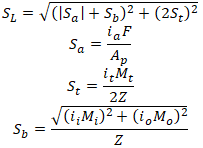Several ASME B31 & EN 13480 Issues Needed to Know for Pipe Stress Engineer
Axial Stress from Pressure Load, Axial Force and Torsion Moment
This issue lead to serious under-estimation sustained and expansion stresses in pipes and fittings in ASME B31.1-2018, ASME B31.4-2016, ASME B31.5-2016, ASME B31.8-2016, EN 13480-2017, ISO 14692 and some other codes.
For example let’s take ASME B31.1-2018 code that requires using following equation for stress from sustained loads (104.8.1):
![]()
First problem is not so serious for above gorund piping. This equation is suitable only for totally unrestrained pipes, but it is easy to use in manual calculations, and it is always conservative. For more information please refer to article What is Restrained and Unrestrained Pipes. Also in software the more accurate equation is recommended to use for axial stress 102.3.2 a (3):
![]()
Instead of simplified equation, that is more easy for manual calculations
![]()
Second and most serious problem is with formula (104.8.1). It doesn’t take into account axial force in the pipe. Sometimes, axial force from sustained loads can be so huge, that axial stress becomes greater than allowable. Engineers can easily overlook this problem when using pipe stress analysis software for big models. For example it could be very tall vertical pipes or heavy valve on vertical pipe. The code sustained stress for this model is almost zero (see “Sl” stress in the screenshot below). But real sustained stress is greater than allowable (see “Sl*” stress in the screenshot below).
The same problem with expansion stress equation (104.8.3), it doesn’t include axial force too
![]()
For example for totally restrained pipe code expansion stress range will be zero (see “Se” stress in the screenshot below). But real stress range is greater than allowable (see “Se*” stress in the screenshot below).
Sometimes even experienced piping designer can make a mistake and create wrong design. For example in piping system below, the 1-2 pipe is restrained by trunnion 2-4. Code stress range is zero, but if we choose the option to include axial force the stress range is greater than allowable!
To protect users from such mistakes we add the special option in PASS/Start-Prof software that allows taking into account stress from axial force and torsion moment for sustained stress and for expansion stress range . User can simultaneously see official code stresses (Sl, Se) and modified stress (Sl*, Se*) in the same table. It is also automatically solves the first described problem with axial stress from pressure load for restrained, totally unrestrained and middle behavior systems. Axial stress from pressure load (Sl*) will also be more accurate. This option may be activated using “Add axial force and torsion stress” checkbox in Project Settings.
For modified stresses PASS/Start-Prof software use the equations similar to ASME B31.3 code:

We recommend to always switching this option on!




